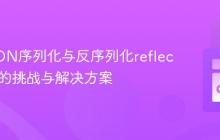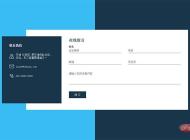-

- Go JSON序列化与反序列化reflect.Type的挑战与解决方案
- 在Go语言中,直接对reflect.Type类型进行JSON反序列化会导致运行时错误,因为json包无法推断出应实例化的具体类型。本文将深入解析这一问题的原因,并提供实用的解决方案,包括将reflect.Type转换为字符串进行存储,以及在需要时通过类型注册表进行重建,确保类型信息的安全存储与检索。
- web前端 . json 919 2025-10-24 10:13:31
-

- 使用 PHP 统计 JSON 文件中特定子目录下值的总和
- 本文将指导你如何使用PHP遍历包含JSON文件的多个子目录,并计算每个子目录中JSON对象里特定键(例如‘guests’)的值的总和。我们将提供一个清晰的代码示例,并解释每一步骤的原理,帮助你理解和应用该方法。
- web前端 . json 827 2025-10-24 10:11:01
-

- Java中如何将Map转换为JSON字符串
- 最常用方式是使用Jackson或Gson库。先添加对应Maven依赖,再分别通过ObjectMapper的writeValueAsString()或Gson的toJson()方法将Map转为JSON字符串,两者均几行代码即可完成转换。
- web前端 . json 273 2025-10-24 09:53:01
-

- 解决Firefox中iframe加载Base64编码文本的跨浏览器方案
- 本文旨在解决在不同浏览器中,特别是Firefox,通过data:URI将Base64编码的文本内容加载到iframe时遇到的兼容性问题。我们将探讨传统iframe.src方法的局限性,并提出一种更为健壮的跨浏览器解决方案,即直接通过iframe.contentDocument.body注入解码后的文本内容,确保在Chrome、Edge和Firefox等主流浏览器中都能实现预期效果。
- web前端 . json 454 2025-10-24 09:48:30
-

- React useState:高效更新数组中特定元素的属性
- 本文详细介绍了在React中使用useStateHook管理数组状态时,如何正确地更新数组中特定元素的属性。核心在于遵循React的不可变性原则,通过创建新数组而非直接修改现有状态。文章提供了两种主要方法:利用map函数进行通用条件更新,以及通过索引结合展开运算符进行特定位置更新,并附带示例代码和最佳实践,帮助开发者安全、高效地管理复杂数组状态。
- web前端 . json 280 2025-10-24 09:41:13
-

- composer怎么处理需要系统库(如gd, imagick)的依赖_解析处理依赖系统库的composer方法
- Composer仅检查PHP扩展依赖,需手动安装系统库。在composer.json中声明ext-gd、ext-imagick等依赖可触发环境检查,确保GD、ImageMagick等扩展可用。实际安装需通过系统包管理器(如apt、yum、brew)安装libgd、ImageMagick等底层库,并配置PHP扩展。推荐使用Docker或部署脚本统一环境,避免运行时错误,保障开发与生产环境一致。
- web前端 . json 714 2025-10-24 09:41:02
-

- Go语言中构建可扩展的JSON解组库:优雅处理自定义结构体
- 本文探讨了Go语言库在处理JSON解组时,如何优雅地支持应用程序自定义扩展结构体的挑战。针对传统allocator模式的局限性,文章提出了一种“富请求对象”策略:库提供一个包含公共字段和原始JSON数据的Request结构体,并附带Unmarshal方法。应用程序通过此Request对象自行将原始JSON解组到其特有的结构体中,从而实现高度解耦和灵活扩展,避免了库对具体业务类型的高度依赖。
- web前端 . json 956 2025-10-24 09:39:35
-

- Golang反射实现通用打印函数项目
- 答案:Go反射可实现通用打印函数,通过reflect.Value和Type获取变量类型与值,遍历结构体、切片、map等类型并递归输出字段名与值,支持标签美化显示,适用于调试、日志、API中间件等场景,但需注意性能开销与空指针、循环引用处理。
- web前端 . json 810 2025-10-24 09:36:02
-

- 动态生成输入框在PHP表单提交后保留值的方法
- 本文旨在解决JavaScript动态创建的表单输入框在PHP提交后无法自动保留用户输入值的问题。通过将PHP的$_POST数据转换为JSON格式,并将其嵌入到JavaScript变量中,我们可以在页面重新加载时,利用JavaScript读取这些数据,并动态地将值填充回相应的输入框,从而实现用户输入的持久化。
- web前端 . json 301 2025-10-24 09:29:02
-

- PHP与XPath:高效合并XML日历中的同日事件
- 本教程详细介绍了如何使用PHP的SimpleXML和XPath功能,处理结构化XML日历数据。面对多个事件在同一日期分散显示的问题,我们将学习如何通过XPath查询提取唯一日期,并在此基础上将同一日期的所有事件描述进行分组展示,从而实现清晰、聚合的日历视图,避免重复日期标题,提升数据可读性。
- web前端 . json 494 2025-10-24 09:22:31
-

- Golang中JSON反序列化reflect.Type的正确姿势
- 本文旨在解决Golang中使用encoding/json包反序列化reflect.Type类型时遇到的问题。由于reflect.Type是一个接口,JSON包无法确定反序列化后的具体类型,直接反序列化会导致panic。本文将探讨问题的原因,并提供几种可行的解决方案,帮助开发者安全地存储和检索reflect.Type信息。
- web前端 . json 483 2025-10-24 09:17:10
-

- 深入理解Jedis jsonGet 方法对字节数组的处理及解决方案
- 在使用Jedis4.2.3客户端通过UnifiedJedis.jsonGet()方法获取存储在Redis中的JSON数据时,如果JSON字段中包含表示字节数组的数值列表,Jedis内部的JSON解析库(如Gson或org.json:json)可能会将这些数值自动向上转型为double类型,导致输出结果带有.0后缀。本文将详细探讨这一现象的原因,并提供三种有效的解决方案,包括数据后处理、利用Path进行精确类型转换以及执行原始命令,帮助开发者正确获取原始字节数据。
- web前端 . json 1004 2025-10-24 09:15:40
-

- 如何使用PHP分别计算特定子目录中JSON对象的值的总和
- 本文档旨在指导开发者使用PHP语言,针对包含JSON文件的目录结构,实现按月统计JSON文件中guests字段的总和。通过提供的代码示例,读者将学习如何遍历目录、读取JSON文件以及累加特定字段的值,最终输出每个月的总人数。
- web前端 . json 404 2025-10-24 09:15:18
-

- WordPress循环中动态生成JSON并避免末尾逗号的技巧
- 本文探讨在WordPress循环中动态生成JSON结构时,如何避免因手动拼接字符串而产生的末尾逗号问题。文章将介绍两种解决方案:一种是利用WP_Query的内部属性进行条件判断来控制逗号输出,另一种是推荐使用PHP内置的json_encode函数,通过构建完整的PHP数组结构再统一编码,以确保生成符合规范的JSON字符串,避免手动处理的复杂性和潜在错误。
- web前端 . json 243 2025-10-24 09:13:01
-

- composer如何配置和使用国内镜像源解决下载慢问题
- 配置国内镜像源可提升Composer下载速度,推荐使用阿里云、LaravelChina或腾讯云镜像,通过composerconfig-g设置全局源,单个项目可在composer.json中添加repositories配置,验证可用composerconfig-l检查生效情况。
- web前端 . json 511 2025-10-24 09:05:02

PHP讨论组
组员:3305人话题:1500
PHP一种被广泛应用的开放源代码的多用途脚本语言,和其他技术相比,php本身开源免费; 可以将程序嵌入于HTML中去执行, 执行效率比完全生成htmL标记的CGI要高许多,它运行在服务器端,消耗的系统资源相当少,具有跨平台强、效率高的特性,而且php支持几乎所有流行的数据库以及操作系统,最重要的是





























